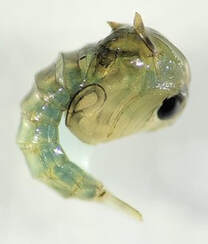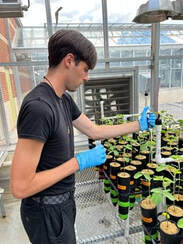|
written by: Mariom Carvajal Insects are critical to the function of ecosystems and provide benefits to humans, such as pollination and biological control. Although many insects hold great economic and cultural value to humans and benefit our lives, some reduce agricultural productivity and others pose risks to human health. To find new ways to manage these pests, some Entomologists turn to the study of invisible cellular processes or insect-microbe interactions. Two research in progress talks presented on March 10th 2023 by University of Maryland researchers, Dr. Anastasia Naumenko and Mr. Brendan Randall, focused on how knowledge of these microscopic processes can be used for the benefit of agricultural and public health systems. Innovations in mosquito control Mosquitoes are small flies that belong to the family Culicidae. These flies have a life cycle that involves complete metamorphosis, meaning their larvae transition into a pupal stage before the adult emerges. Mosquito eggs and larvae develop in aquatic systems in which the immatures feed on debris and microorganisms. In the adult stage, however, the adults develop piercing sucking mouthparts. While males feed mostly on nectar, females feed on both nectar and blood, the latter of which permits disease transmission. Diseases transmitted by mosquitoes, most commonly in the genera Anopheles, Aedes, and Culex are malaria, Zika, yellow fever and West Nile fever, which range from difficult to treat to untreatable. According to the CDC, the combined burden of mosquito-borne disease results in more than five hundred thousand deaths annually. Current strategies to reduce mosquito populations include removal of water from open outdoor containers, application of larvicide, and more recently the introduction of genetically modified mosquitoes that cannot reproduce. This last strategy demonstrates the importance of studying gene function. Genetic material in most organisms is contained in DNA molecules. DNA is a coded set of instructions, and for cells to be able to understand these instructions they must be converted into a “cell language" known as RNA. Expression of this cell language, or RNA expression, guides cellular machinery to construct proteins, which are considered the building blocks of an organism. Genes are discrete units of DNA, which encode proteins with specific functions in an organism. To understand the function of genes, scientists can "knock down" or prevent their expression. This results in phenotypic changes which are sometimes related to observable physical traits, thus revealing gene function. Knocking down a gene can involve RNA interference (RNAi), a process in which part of the information contained in RNA is deleted, causing changes to protein production. Even though this process occurs in nature, it can be achieved artificially by introducing a molecule responsible for interference into an insect through their food or by microinjection. Use of these approaches can efficiently knock down genes in some insect species and life stages but have drawbacks in others. Inspired by work from Arshad et al. (2021) on Aedes aegypti, Dr. Anastasia Naumenko, a post-doctoral researcher at the University of Maryland proposed a novel procedure for inducing RNAi in Culex pipiens pupae and targeted a gene responsible for melanization as proof of concept.  Fig. 1. Cx. pipiens pupae treated with liquid dsRNA. Brilliant Blue allows visualization of liquid uptake. (Picture courtesy from Dr. Naumenko) Fig. 1. Cx. pipiens pupae treated with liquid dsRNA. Brilliant Blue allows visualization of liquid uptake. (Picture courtesy from Dr. Naumenko) Dr. Naumenko's assay involved soaking dehydrated Cx. pipiens pupae (Fig. 1) in double stranded RNA (dsRNA), one molecule responsible for RNA interference. Soaking of pupae in dsRNA specific to this gene reduced tanning of the developing adult's cuticle, as well as decreased survival of a portion of the specimens being tested. This soaking method is an innovative way of achieving partial gene knock down without the need for microinjections. The development of this technique helps to broaden the study of gene function in insects, which can lead to the discovery of genes that could serve as excellent targets for mosquito management. Effects of soil microorganisms on plant-insect interactions Nitrogen is one of the essential elements needed for the existence of life. This element is present in DNA, proteins as well as other organic molecules. Nitrogen circulates in the environment in a process called the Nitrogen Cycle which is possible thanks to bacteria. These bacteria can fix the nitrogen from the atmosphere and the soil, converting it into products that plants can absorb. One of these bacteria, Rhizobium (plural rhizobia), is known to fix nitrogen for leguminous plants. In this way, a symbiotic relationship is developed in which rhizobia form nodules on the plant’s root, providing the plant with nitrogen. Authors Gonzalez et al. (2019) indicate that the number of rhizobia species is more than sixty; many of them containing multiple strains.  Fig. 2. University of Maryland Ph.D. student Brendan Randall working in rhizobia manipulation in a greenhouse. Fig. 2. University of Maryland Ph.D. student Brendan Randall working in rhizobia manipulation in a greenhouse. According to University of Maryland PhD student Brendan Randall, recent studies suggest that combinations of different species and amounts of rhizobia result in different growth rates in plants. Currently, Randall is studying the effects of manipulating rhizobia in agricultural complexes in Maryland (Fig. 2). Randall proposed an experiment in which field conditions changed between watered and drought while also changing the rhizobial community using a variety of species. His results confirmed the relationship between rhizobial communities and plant development. Moreover, these changes in rhizobial community and environment factors were found to be related to caterpillar growth rates, providing novel insight into management strategies in soybean fields. Knowledge on plant-insect interactions is essential for developing pest management strategies and understanding these relationships within agricultural systems can improve crop yield and agricultural sustainability. The next steps in Randall’s project involve using this information to test questions in ecology and biodiversity in agricultural pest complexes. Acknowledgements Thanks to graduate students in entomology, Robert Salerno and Amanda Brucchieri for their revisions and insightful comments. References ● Arshad, F., Sharma, A., Lu, C., & Gulia-Nuss, M. (2021) RNAi by soaking Aedes aegypti pupae in dsRNA. Insects, 12(7): 634. ● González, V., Santamaría, R. I., Bustos, P., Pérez-Carrascal, O. M., Vinuesa, P., Juárez, S., Martinez I., Cevallos M., Brom S., Martinez E., & D. Romero (2019). Phylogenomic Rhizobium species are structured by a continuum of diversity and genomic clusters. Frontiers in Microbiology, 10: 910. https://doi.org/10.3389/fmicb.2019.00910 ● Mosquito control. Accessed 03/15/2023: https://www.cdc.gov/mosquitoes/mosquito-control/index.html Comments are closed.
|
Categories
All
Archives
June 2024
|
Department of Entomology
University of Maryland
4112 Plant Sciences Building
College Park, MD 20742-4454
USA
Telephone: 301.405.3911
Fax: 301.314.9290
University of Maryland
4112 Plant Sciences Building
College Park, MD 20742-4454
USA
Telephone: 301.405.3911
Fax: 301.314.9290

 RSS Feed
RSS Feed




